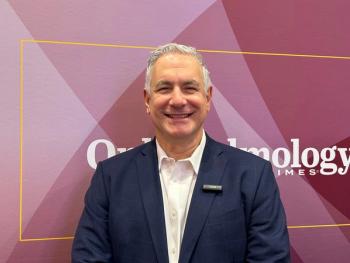
2013 developments put spotlight on integrated OR
New devices show increased interest in providing users with combined surgical systems
Take-Home
Much happened in 2013 for femtosecond laser technology and integrated surgical platforms, however some obstacles still remain.
Dr. Kahook
By Cheryl Guttman Krader
While discussion about the cost-benefit ratio of femtosecond laser-assisted cataract surgery made headway during 2013, the laser manufacturers continued to upgrade their platforms in ways that would improve their performance and make them more user-friendly.
However, perhaps the biggest news in the femtosecond laser arena was the acquisition of OptiMedica by Abbott Medical Optics (AMO).
This piece of business news-plus the new phacoemulsification unit introduced by Alcon Laboratories, the Centurion Vision System-reflect what may be a main theme of the year for cataract surgery: a growing interest in providing users with integrated surgical systems.
“More and more we are seeing manufacturers aiming to integrate their diagnostic and surgical technologies with the goal of helping cataract surgeons achieve improved refractive outcomes and fewer complications,” said Randall Olson, MD, professor and chair, department of ophthalmology and visual sciences and CEO, John A. Moran Eye Center, University of Utah, Salt Lake City.
Dr. Olson, Malik Kahook, MD, The Slater Family Endowed Chair in Ophthalmology and Professor of Ophthalmology, University of Colorado, Denver, and Mark Packer, MD, private practice, Bowie, MD, and clinical associate professor of ophthalmology, Oregon Health & Science University, Portland, spoke to Ophthalmology Times about recent developments in cataract surgery.
Integrating technologies
Dr. Kahook and Dr. Packer consider the opportunity for integration a very attractive feature of the Centurion Vision System. The unit was developed to seamlessly communicate with other Alcon surgical technologies, including the Verion Image Guided System, the LenSx Femtosecond Laser, and the LuxOR LX3 with Q-VUE Ophthalmic Microscope.
“The various pieces of equipment in most operating rooms (ORs) come from a number of different manufacturers, and so there is no way for all of the technology to communicate with each other,” Dr. Packer said. “With its introduction of the Centurion Vision System and Verion imaging-combined with the earlier acquisitions of LenSx and Endure Medical Systems (manufacturer of the LuxOR surgical microscope)-Alcon is well on its way to providing components for building a fully integrated OR. This is a worthwhile goal that all companies should strive toward.”
The acquisition of OptiMedica, Dr. Packer said, puts AMO in a better position to begin to create its own suite of technologies.
He noted that after acquiring Bausch + Lomb, Valeant is continuing to look for growth opportunities and innovation, and he expects to see more developments coming from this company.
However, integration capability is just one of the features of the Centurion Vision System.
Among its other innovations is a proprietary new fluidics system (Active Fluidics Technology) that allows surgeons to set and maintain a target IOP during the procedure.
“The ability to regulate chamber dynamics by programming in IOP rather than adjusting bottle height should offer a major safety benefit,” said Dr. Kahook, who had an opportunity to preview the system prior to its United States launch.
Dr. Packer also thinks the pressurized infusion technology that will allow surgeons to “set and forget” IOP will be very helpful for increasing surgical safety by reducing surge.
“It is not possible to adjust the bottle height fast enough to account for surge that occurs quickly,” Dr. Packer said.
“With all of the advances that have been occurring in cataract surgery technology, it has seemed archaic to still be using gravity infusion with a bottle of BSS hanging over the table,” he added, noting that low OR ceiling height was sometimes a limiting factor in obtaining adequate infusion pressure for performing bimanual microincisional cataract surgery.
Further innovation
Dr. Olson
Another proprietary innovation on the Centurion is its Balanced Energy Technology, which enhances phacoemulsification efficiency through use of OZil Intelligent Phaco and its new INTREPID Balanced tip.
Balanced Energy Technology creates a unique tip motion that allows for finer control of ultrasound application and a reduction in ultrasound usage.
Another newsworthy development in phacoemulsification technology, Dr. Kahook said, was the unveiling of a new portable phacoemulsification unit from Oertli, CataRhex 3.
This novel machine was introduced at the 2013 European Society of Cataract and Refractive Surgeons (ESCRS) Congress in October.
“CataRhex 3 is a first of its kind, compact modern phaco unit that hangs on an IV pole,” Dr. Kahook said. “Since it can travel with the surgeon from one OR to another, it may be attractive to anyone who operates out of several centers and wants to have access to the same technology at each.”
Femtosecond lasers
Dr. Packer
Cost remained a major obstacle to wider adoption of the femtosecond laser in 2013.
“There is no question that traditional phacoemulsification is a great surgery, and so it is hard to justify use of a new, very expensive device that perhaps can provide only incremental benefits,” Dr. Kahook said.
However, multimodal capability can be an attractive feature to buyers, he added.
Some units already have additional corneal surgery indications, and surgeons can expect to see devices with expanded functions that may include applications for glaucoma surgery, Dr. Kahook said.
Dr. Packer highlighted a 2013 paper from Australian cataract surgeons on the cost-effectiveness of femtosecond laser-assisted cataract surgery [Abell RG, Vote BJ. Ophthalmology. 2013; Oct 10, epub ahead of print].
The authors compared femtosecond laser-assisted and conventional cataract surgery using published data on outcomes and time trade-off utility values converted from visual acuity results. Not surprisingly, said Dr. Packer, they concluded the laser procedure was not cost-effective.
“The improvements gained from switching to laser surgery from standard phacoemulsification are incremental, not revolutionary like they were when going from extracapsular cataract extraction to phaco,” he said. “However, the laser technology is still young, and its potential probably goes far beyond what is even being talked about today.
“There is reason to be excited, but the enthusiasm has to be tempered with a dose of realism,” Dr. Packer said.
Dr. Olson said he has no doubt that use of the femtosecond laser can make a difficult cataract surgery case more straightforward, but whether it offers an advantage in routine surgery is unclear and there is still controversy over whether it improves refractive results.
As the femtosecond laser can create a more perfect capsulotomy than a manual technique, it is theorized that its use should be associated with more predictable IOL position and therefore a better refractive outcome.
However, Dr. Olson noted that in a study presented at the 2013 ESCRS Congress, Oliver Findl, MD, questioned whether the laser-assisted procedure would result in better and more predictable IOL position.
Dr. Findl evaluated the effect of rhexis size and shape on IOL tilt, decentration, and anterior chamber depth (ACD) at 3 months in 254 eyes operated on with a manual technique and implanted with one of several modern IOLs. He found no difference in ACD or tilt comparing eyes with a suboptimal rhexis versus controls, and only a little difference in decentration, which he said was probably clinically irrelevant.
Consistent with Dr. Findl’s conclusion, another published study from the Australian cataract surgeons found no differences in visual acuity or refractive outcomes comparing groups of eyes operated on with a laser-assisted versus conventional technique [Abell RG, et al. Ophthalmology. 2013; 120 (5): 942-8].
However, the results did show that the laser-assisted procedure reduced effective phacoemulsification time by 83%, allowed for a zero ultrasound procedure in 30% of eyes, and reduced endothelial cell loss by 36%.
“This paper provides great support for the safety advantages of using the laser to fragment the lens,” Dr. Packer said. “However, the lack of any benefit for improving vision or reducing refractive error was interesting because many surgeons think those are advantages of using the laser for capsulotomy. In fact, in the economic model in the United States, the justification for charging extra for the laser is that it delivers a better refractive outcome for patients having a premium surgery procedure.”
Other articles of interest
Another publication in the peer review literature on femtosecond lasers that Dr. Packer thought was worth mentioning was an article in the April edition of Journal of Cataract & Refractive Surgery [Talamo JH, et al. J Cataract Refract Surg. 2013; 49(4): 501-10], that compared two different optical patient interfaces on a prototype of the OptiMedica laser.
The two technologies were tested in bench and clinical studies, and the results showed multiple advantages for using a liquid optical immersion interface instead of a curved contact lens interface.
“The liquid interface between the laser and the eye minimizes compression and therefore reduces corneal folds,” Dr. Packer said. “Since the corneal folds act to scatter laser light, the capsulotomy may contain skip areas that increase the potential for an anterior capsule radial tear.”
He noted that only the OptiMedica and Lensar laser systems feature the liquid patient interface.
A third paper from the Australian cataract surgeons that gained Dr. Packer’s interest raised a safety concern with laser capsulotomy [Abell RG, et al. Ophthalmology. 2013; Epub ahead of print].
The study compared femtosecond laser-assisted and conventional phacoemulsification surgery in groups of about 800 eyes each. Four surgeons who used three different femtosecond lasers performed the procedures. The analyses found a significantly higher rate of anterior capsule tears in eyes undergoing femtosecond laser-assisted surgery than in a control group, 1.87% vs. 0.12%.
Of the 15 anterior capsule tears that occurred in the femtosecond laser group, seven extended all the way to the posterior capsule.
“Most of the eyes with a tear did well,” Dr. Packer said. “However, a wraparound tear is certainly not a good thing, and some eyes needed a vitrectomy and ended up with a sulcus lens. Cataract surgery with the femtosecond laser is an evolving story. Now, the potential for an increased risk of capsular tears is one issue that the laser manufacturers need to look at.”
The study authors proposed a few reasons to explain the greater risk of anterior capsule tears with the femtosecond laser, including the fact that the laser creates a capsulotomy with postage-stamp perforations and aberrantly placed pulses as the result of saccadic eye movement.
Dr. Packer suggested that capsulotomy size might also be an explanation.
He observed that the capsulotomies had an average D < 5 mm, which is consistent with what appears to be a trend for surgeons to create smaller capsulotomies when using the laser than when performing a manual technique.
He noted a smaller capsulotomy might predispose to tearing because its rim is less elastic and weaker-because the capsule is thinner-than that of a larger capsulotomy.
Dr. Packer believes the reason why surgeons may be creating smaller capsulotomies with the laser is that they are centering the opening on the optical axis in order to optimize visual outcomes with their premium IOLs.
However, in doing so, the capsulotomy is decentered relative to the capsule. In the latter situation, making a smaller capsulotomy helps to ensure that there is 360° overlap of the capsular rim over the optic and that the IOL remains stable in the capsular bag.
Mark Packer, MD
Dr. Packer is a consultant to Abbott Medical Optics and Lensar.
Randall Olson, MD
Dr. Olson has no relevant financial interests to disclose.
Malik Kahook, MD
Dr. Kahook is a consultant to Alcon, Allergan, ClarVista Medical, Aerie Pharma and the FDA. He has intellectual property interests with AMO, Glaukos, New World Medical, Oasis, ClarVista Medical and Prospex Medical.
Newsletter
Don’t miss out—get Ophthalmology Times updates on the latest clinical advancements and expert interviews, straight to your inbox.



















































.png)


